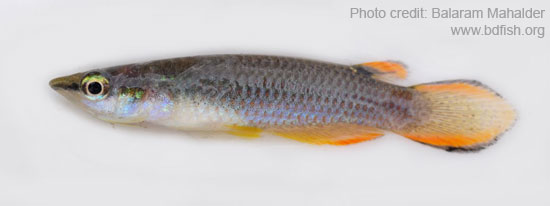
Synonyms:
Esox panchax Hamilton, 1822, Fishes of the Ganges, p.221.
Haplochilus panchax Day, 1878, Fishes of India. p. 523.
Panchax panchax Weber and de Beaufort, 1922, Fishes of the Indo-Australian Archipelago. 4, p. 374.
Aplocheilus panchax Smith, 1945, Fishes of Siam or Thailand. p. 422.
Aplocheilus panchax Sterba, 1962, Freshwater Fishes of the world. p. 480.
Common name: Top-minnows, Blue panchax
Local name: Kanpona, Choukkani
Taxonomy position:
Phylum- Chordata
Class-Oesteichthyes
Order- Cyprinodontiformes
Family- Cyprinodontidae
Genus- Aplocheilus McClelland
Fin formula:
D. 7-8; P1. 13-15; P2. 6; A. 15-16. (Rahman, 2005)
Description of the species:
Head depressed but tail compressed. Jaws are equal, maxilla reaches near front margin of eye. Mouth is moderate and anterior in position. Tongue rounded. Head 3.2-3.6 in standard and 4.2-4.8 in total length, Height 4.0-4.8 in standard and 5.4-6.2 in total length (Rahman, 1989). Dorsal fin situated well back, originates from above posterior base of anal. Origin of pelvic fins is from below middle of pectoral and reach anal. Anal fin reaches caudal. Caudal fin is rounded in mature specimens, somewhat pointed in young. Origin of anal is nearer to caudal base than to tip of snout. Lateral line is absent upper surface of head scaled. Upper surface of body is greenish, dull white beneath. Fins are yellowish. Margin of vertical fins is orange. A white spot is found at the occiput.
Habit and Habitat:
This fish is seen at the surface in schools in marginal water and abundant in ditches, ponds, canals, rivers and other water areas throughout Bangladesh.
Economic importance:
This species is freely reared in aquaria as an ornamental fish and should be kept only with fishes of its own size. Breeding of the species is best accomplished in a small tank.
Ecological role:
This is a valuable larvivorous fish and its utility for mosquito control has been established.
Status and conservation:
This species is available in study area (Barnai River, Rajshahi) and not listed in IUCN Red list as threatened.
References:
Day, F. 1878. Fishes of India, being a natural history of fishes known to inhabit the seas and freshwaters of India, Burma and Ceylon. William Dawson & Sons Ltd., London, Vol. I: 778 pp.
Hamilton, F., 1822. An account of the fishes found in the river Ganges and its branches, Edinburgh & London, Fishes Ganges, 405 p.
Rahman, A.K.A. 1989. Freshwater Fishes of Bangladesh. The Zoological Society of Bangladesh, Department of Zoology, University of Dhaka, Dhaka-1000. 364 pp.
Rahman, A.K.A. 2005. Freshwater Fishes of Bangladesh (Second edition). The Zoological Society of Bangladesh, Department of Zoology, University of Dhaka, Dhaka-1000. 394 pp.
Smith, H.M. 1945. The freshwater fishes of Siam or Thailand. United States National Bulletin- 188. 422 p.
Sterba, G. 1963. The freshwater Fishes of the world. Translated and revised by D. W. Tucker. London. 878 pp.
Weber, M. and de Beaufort, L.F. 1922. The fishes of the Indo-Australian archipelago. Vol.IV. Publ. E. Brill. Leiden. 374 p.
Visited 3,306 times, 1 visits today | Have any fisheries relevant question?
